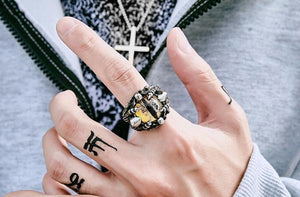Styles of Gothic Rings: A Brief Guide
When Gothic first appeared in the Middle Ages, it mainly affected architecture. Over the course of time, however, applied art, including jewelry, was also influenced by this style. The early Gothic ornaments were distinguished by massiveness and, as a rule, they carried a kind of symbolic content characteristic of the cultural traditions of the Middle Ages.
Times have changed, but Gothic, as a phenomenon, continues existing. At the moment, it has a huge number of interpretations. Some people believe that Gothic is only a youth subculture, which featuring dark clothes, bleached skin, and peculiar symbolism. However, this is not quite true. Nowadays, we can see several trends in Gothic, each of which has its own unique appearance. Let's see how many Gothic styles are around and what features they have.
Cold Contrast
Such items are most often made of white gold, silver or platinum, symbolizing thereby death and restraint. As inserts, stones of contrasting color are used - rubies, sapphires, onyx, and black diamonds. It is easy to guess what this color palette symbolizes: red is blood while black and dark blue denote darkness and gloominess. Besides the color palette, such products are distinguished by intricate details, heraldic patterns, and fine craftsmanship. These are delicate and very feminine pieces.
Symbolic Stylization
This style can be considered as a vivid demonstration of what a gothic is like in the minds of most people. Large skulls, crosses, and subcultural attributes – this is how many designers see Gothic. Although such jewelry items are predominantly made of white metals and often feature stone and gem inserts, they hardly resemble the previous style. Whether it is a skeleton hand gothic ring or a cross pendant, such products tend to be less subtle and more heavyweight.
Renaissance
Despite the fact that modern "Goths" are associated with darkness, rigidity, and occult rites, the original Gothic jewelry is a combination of subtle lace often complemented with pearl inserts. Unlike other styles of gothic jewelry with their gloomy tones or contrast inlays, Renaissance products are known thanks to pastel and white colors. Like the English Gothic cathedrals that are distinguished by arched vaults and sharp corners, these jewelry items convey mystery through grace and splendor.
Subcultural Gothic
This style includes items that we most often see on Goths and Gothesses - studded jewelry, massive rings, heraldic amulets, etc. This trend can be considered as a "classic" of modern Gothic. The prominent feature of such ornaments is some sort of androgenic because the same items can be worn by both male and female Goths. Besides this, Gothic jewelry of this style often appeals to sexuality.
Vampire style
This style is a combination of the historical understanding of Gothic and its current interpretation. On the one hand, this is the classical semantic content of each product. The most popular symbols characteristic of Vampire style are spiders, bats, and attributes of the afterlife. On the other, it features a modern bias to contrast, as we can see in the Cold Contrast style.

